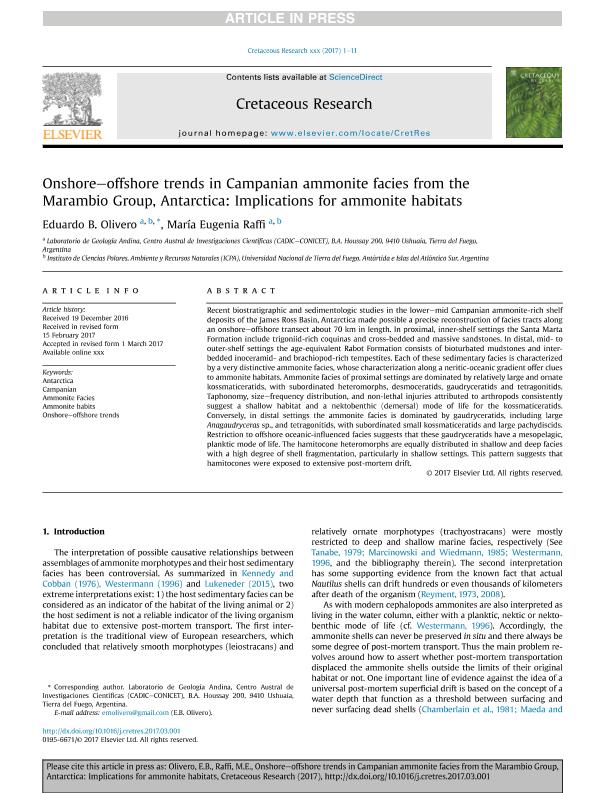Mostrar el registro sencillo del ítem
dc.contributor.author
Olivero, Eduardo Bernardo

dc.contributor.author
Raffi, María Eugenia

dc.date.available
2018-08-15T16:12:32Z
dc.date.issued
2018-08
dc.identifier.citation
Olivero, Eduardo Bernardo; Raffi, María Eugenia; Onshore–offshore trends in Campanian ammonite facies from the Marambio Group, Antarctica: Implications for ammonite habitats; Academic Press Ltd - Elsevier Science Ltd; Cretaceous Research; 88; 8-2018; 79-89
dc.identifier.issn
0195-6671
dc.identifier.uri
http://hdl.handle.net/11336/55622
dc.description.abstract
Recent biostratigraphic and sedimentologic studies in the lower–mid Campanian ammonite-rich shelf deposits of the James Ross Basin, Antarctica made possible a precise reconstruction of facies tracts along an onshore–offshore transect about 70 km in length. In proximal, inner-shelf settings the Santa Marta Formation include trigoniid-rich coquinas and cross-bedded and massive sandstones. In distal, mid- to outer-shelf settings the age-equivalent Rabot Formation consists of bioturbated mudstones and interbedded inoceramid- and brachiopod-rich tempestites. Each of these sedimentary facies is characterized by a very distinctive ammonite facies, whose characterization along a neritic-oceanic gradient offer clues to ammonite habitats. Ammonite facies of proximal settings are dominated by relatively large and ornate kossmaticeratids, with subordinated heteromorphs, desmoceratids, gaudryceratids and tetragonitids. Taphonomy, size–frequency distribution, and non-lethal injuries attributed to arthropods consistently suggest a shallow habitat and a nektobenthic (demersal) mode of life for the kossmaticeratids. Conversely, in distal settings the ammonite facies is dominated by gaudryceratids, including large Anagaudryceras sp., and tetragonitids, with subordinated small kossmaticeratids and large pachydiscids. Restriction to offshore oceanic-influenced facies suggests that these gaudryceratids have a mesopelagic, planktic mode of life. The hamitocone heteromorphs are equally distributed in shallow and deep facies with a high degree of shell fragmentation, particularly in shallow settings. This pattern suggests that hamitocones were exposed to extensive post-mortem drift.
dc.format
application/pdf
dc.language.iso
eng
dc.publisher
Academic Press Ltd - Elsevier Science Ltd

dc.rights
info:eu-repo/semantics/openAccess
dc.rights.uri
https://creativecommons.org/licenses/by-nc-sa/2.5/ar/
dc.subject
Ammonite Facies
dc.subject
Ammonite Habits
dc.subject
Antarctica
dc.subject
Campanian
dc.subject
Onshore–Offshore Trends
dc.subject.classification
Meteorología y Ciencias Atmosféricas

dc.subject.classification
Ciencias de la Tierra y relacionadas con el Medio Ambiente

dc.subject.classification
CIENCIAS NATURALES Y EXACTAS

dc.title
Onshore–offshore trends in Campanian ammonite facies from the Marambio Group, Antarctica: Implications for ammonite habitats
dc.type
info:eu-repo/semantics/article
dc.type
info:ar-repo/semantics/artículo
dc.type
info:eu-repo/semantics/publishedVersion
dc.date.updated
2018-08-15T14:21:06Z
dc.journal.volume
88
dc.journal.pagination
79-89
dc.journal.pais
Estados Unidos

dc.journal.ciudad
Nueva York
dc.description.fil
Fil: Olivero, Eduardo Bernardo. Consejo Nacional de Investigaciones Científicas y Técnicas. Centro Austral de Investigaciones Científicas; Argentina. Universidad Nacional de Tierra del Fuego; Argentina
dc.description.fil
Fil: Raffi, María Eugenia. Consejo Nacional de Investigaciones Científicas y Técnicas. Centro Austral de Investigaciones Científicas; Argentina. Universidad Nacional de Tierra del Fuego; Argentina
dc.journal.title
Cretaceous Research

dc.relation.alternativeid
info:eu-repo/semantics/altIdentifier/doi/http://dx.doi.org/10.1016/j.cretres.2017.03.001
dc.relation.alternativeid
info:eu-repo/semantics/altIdentifier/url/https://www.sciencedirect.com/science/article/pii/S0195667116304049
Archivos asociados
